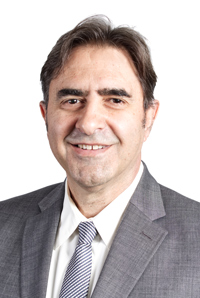(Diverging) Diamonds Can Be a Driver’s Best Friend
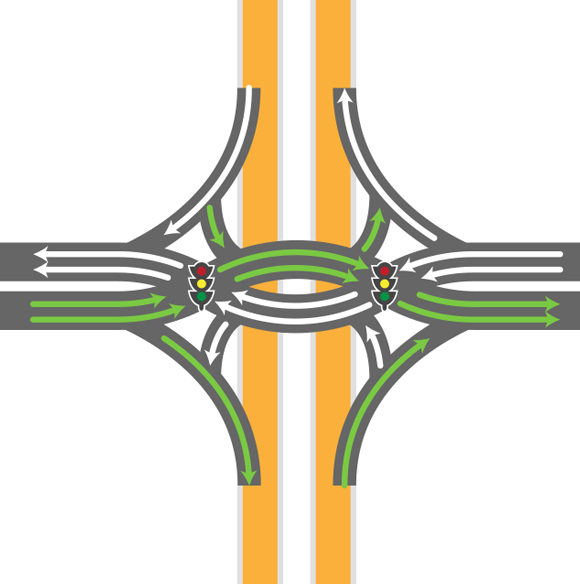
| The diverging diamond interchange improves the flow of traffic entering and exiting the interstate while improving safety for motorists and pedestrians. |
An innovative interchange design that helps improve safety and traffic flow is coming to the Interstate 4 (I-4) corridor – the Diverging Diamond Interchange (DDI). Current design plans for I-4 Beyond the Ultimate call for six DDIs to be built at I-4 interchanges in Osceola, Orange, Seminole, and Volusia counties.
A DDI is normally built where an interstate highway meets a busy local roadway, and is an improvement on the traditional diamond interchange.
A DDI has two unique features that help enhance safety and move traffic more efficiently. First, traffic on the local road switches sides as it approaches the interstate highway. This switch happens at a traffic signal. After the local traffic has traveled over or under the interstate highway, it switches back at another traffic signal.
By temporarily moving local traffic to the other side of the road, a DDI eliminates left turns across oncoming traffic. This includes left turns by drivers getting on the interstate and those exiting the interstate to the local road. The improved left turns increase the efficiency of the interchange, allowing more vehicles to enter and exit the interstate highway.
Eliminating left turns across oncoming traffic has two additional benefits. First, it reduces the number of traffic light phases from four to two. Longer green lights also allow more vehicles to travel through the interchange. Second, it reduces the number of vehicle-to-vehicle conflict points, which decreases the number and severity of crashes. This makes a DDI safer compared to traditional interchanges.
This new design is as safe as a traditional interchange for pedestrians and bicyclists.
The DDI was introduced in the United States in 2009. The first DDI in Florida was built in 2017 at the interchange between University Parkway and Interstate 75 (I-75). I-4’s first DDI will be built at the Sand Lake Road (State Road (S.R.) 482) interchange. Additional DDIs are planned for the County Road (C.R.) 532, Daryl Carter Parkway, Lake Mary Boulevard, C.R. 46A, and S.R. 472 interchanges.
For more about DDIs on I-4 Beyond the Ultimate, visit the Special Features page on I4Beyond.com.
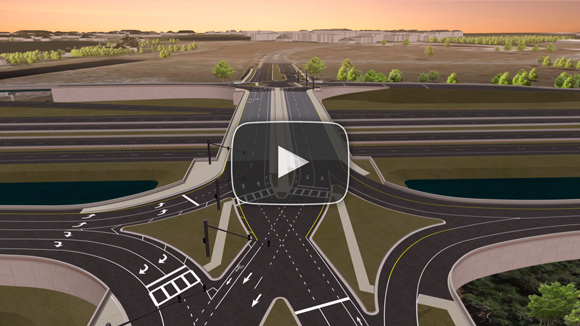
|
|
Biological Assessments Protect
Central Florida’s Natural Assets

Before construction begins on a road improvement project like I-4 Beyond the Ultimate, the Florida Department of Transportation (FDOT) conducts one or more Endangered Species Biological Assessments. These assessments determine if construction will adversely affect wildlife and plant species and, if so, includes strategies to minimize the effects.
The endangered species assessments are part of the Project Development and Environment (PD&E) study.
“One of the visions of FDOT is to preserve the quality of the environment and the community,” Catalina Chacon, FDOT Consultant Project Manager Supervisor, said. “By protecting endangered species, we are ensuring there’s going to be a continuity of the quality of life for Floridians while providing a reliable transportation network.”
For I-4 Beyond the Ultimate, the assessments began with the identification of wildlife and plant species and their habitats that have regulatory protection as federal- or state-listed endangered species or threatened species of special concern. The final list includes 92 wildlife species and 119 plant species known to live or that could potentially be living within the I-4 Beyond the Ultimate corridor in Orange, Osceola, Polk, Seminole, and Volusia counties.
Biologists then did field surveys within the existing Interstate 4 (I-4) right of way and a 500-foot buffer, and all potential stormwater pond sites. The surveys were completed between 2013 and 2015 in each of the six design segments of I-4 Beyond the Ultimate and followed procedures outlined by the U.S. Fish and Wildlife Service and the Florida Fish and Wildlife Conservation Commission.
Biologists observed six threatened wildlife species, two wildlife species of special concern and two endangered plant species.
| Observed Wildlife and Plant Species |
| Threatened Wildlife |
Wildlife of Special Concern |
Endangered Plants |
| Bluetail Mole Skink |
Little Blue Heron |
Scrub Lupine |
| Eastern Indigo Snake |
Sherman's Fox Squirrel |
Scrub Plum |
| Florida Scrub-Jay |
|
|
| Gopher Tortoise |
|
|
| Sand Skink |
|
|
| Wood Stork |
|
|
To protect those species during construction, the biologists and environmental scientists developed a list of recommendations and commitments for the construction projects. Where impacts to a species are unavoidable, FDOT will work with state and federal authorities to relocate wildlife and replant plant species in approved public conservation areas.
View the Endangered Species Biological Assessments for all of the I-4 Beyond the Ultimate design segments at i4Beyond.com/pde.
|
|
Thousands of Students Explore Transportation Construction Industry
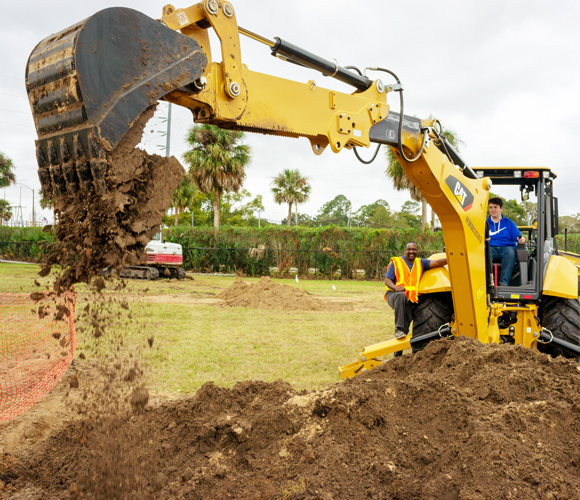
About 3,000 junior and senior high school students got a taste of the transportation construction industry in January at the 19th annual Central Florida Construction Career Days event.
The event, hosted by the Florida Department of Transportation (FDOT) and its industry partners, helps teenagers explore, and build a strong foundation for a successful future in transportation construction. The hope is that the students become interested and one day work on infrastructure endeavors such as the I-4 Ultimate or I-4 Beyond the Ultimate projects.
“Construction Career Days is a great opportunity to introduce tomorrow’s potential tradespeople to today’s roadbuilding industry,” said Geoff Scales, Senior Project Manager with Hubbard Construction Company and co-chair of the event.
Junior and senior high school students from more than 70 Central Florida schools throughout nine counties attended Construction Career Days to learn about the many available opportunities and experience some skilled trades firsthand.
Engineers and skilled trade workers from local firms, technical schools, and FDOT held more than 30 interactive learning labs. Students even got a chance to try their hand at operating heavy equipment and simulators.
Construction opportunities represented through the program are not minimum-wage jobs, but rather steady careers. “These are careers that you can grow with. If you’ve got the ambition and the drive, you can build a career in the construction industry and go far,” Scales added.
Students who attended the event may apply for a $1,000 scholarship. Schools, sponsors and volunteers interested in participating in the 2020 event can visit CCDFL.org.
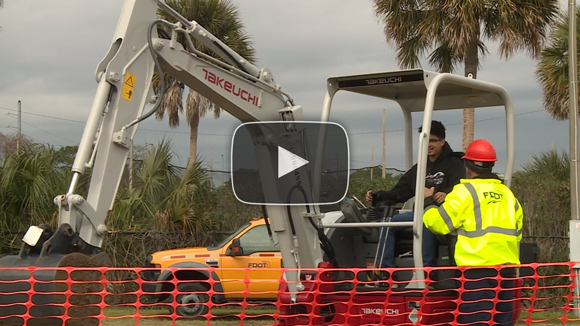
|
|
Employee Spotlight: Mario Bizzio, P.E.
FDOT District Five, District Design Engineer
Mario Bizzio knows it takes a wide variety of teammates to build the two huge road construction projects known as I-4 Ultimate and I-4 Beyond the Ultimate. And he knows it firsthand.
As the District Design Engineer for the Florida Department of Transportation’s (FDOT) District Five, he leads a team of 120 members who are responsible for the engineering behind roadway design, drainage, pavement, utilities, mapping, surveying, bridges, and structures. During his 24 years with FDOT, he also has worked in areas dealing with environmental issues, bridge rehab, design, and maintenance, as well as program management administration.
By itself, that’s an extremely large team. But Bizzio also includes one other very valuable member — the motorist. “The commuter — the taxpayer — is a player on this team as well,” Bizzio said. “After all, it’s their contribution that ultimately goes into the projects. The work requires many people pulling together, and we all play different roles.”
In his current role, Bizzio also deals with the stakeholders affected by construction. That includes businesses, local governments, residents, families, and all the people who drive Interstate 4 (I-4) along the 60 miles that will be transformed by the two major projects.
“The motorists and residents have been very understanding, and their patience will be rewarded,” Bizzio said. “The new corridor will increase safety and mobility. It will be a sleek, beautiful, efficient design that taxpayers will be proud of.”
Bizzio also takes great pride and pleasure in seeing the many facets of the work coming together, not just from his FDOT team, but also through the many hundreds more people working on the roadway and providing support services. He includes those in the business community who help employees and customers cope with ongoing changes. “We all share the same vision.”
Bizzio went into construction because he liked creating things. He started his own carpentry business focused on the homebuilding industry. He realized that to do more, he’d need more education. So, he sold his company and went back to school to earn a civil engineering degree from the University of Miami. He grew up in Miami, where his family settled after coming to the U.S. from Argentina.
Today, in addition to his parents, Bizzio’s family includes his wife, who was a chemist and now works as Spanish-language interpreter for the Seventh Judicial Circuit Court in Volusia County. Their two sons are students at the University of Florida. One is studying for a doctorate in molecular biology and the other is an undergraduate studying finance.
|
|
|







